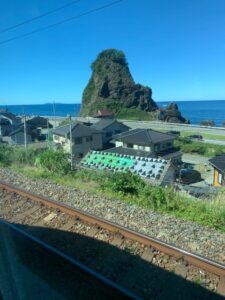
The journey from Tsuruoka to Niigata was delightful, at least on the stretch to Murakami, with views of rocky headlands, small islands, and inlets where the incoming sea has carved bites out of the landmass. Here and there were fields peopled by figures wearing traditional mompe clothing and straw hat, interspersed by long tunnels and a reminder that the mountains had not gone away. They never do in Japan.
For much of the way the track runs close to the sea, passing by fishing villages huddled together for comfort. Shinto shrines spoke of sea spirits, and sacred rope was draped between rocks in picturesque fashion. Old women bent double scoured for seaweed, while out at sea their menfolk bobbed up and down in distant boats. Basho had walked this route, and not surprisingly the poems he and his companion wrote focus on the seaside scenery.
The ferry to Sado leaves from Niigata, an industrial port of importance but not noted for scenic sights. The town exemplifies modernisation, when much of Japan’s heritage was jettisoned in favour of industrial catch-up. Will Ferguson, hitchhiking through here in Hokkaido Blues, described it as ‘sullied and soiled and worn-out’. The Rough Guide is more generous, calling it ‘a likeable but unexciting city,’ Lonely Planet dismisses the town altogether, saying ’There is little to see in Niigata.’
In 1879 Isabella Bird had a very different impression. Bird’s Niigata is a ‘handsome, prosperous city’ of beautiful tea houses, excellent theatres, attractive houses and miniature gardens at the back of long narrow buildings. It is an Oriental Venice in which life centres around canals and goods are delivered by boat. The town is picturesque, Bird tells us, but then adds an ominous note: ’The Niigata of the Government, with its signs of progress in a western direction, is quite unattractive-looking as compared with the genuine Japanese Niigata.’ Here we have surely the earliest expression of the ‘Lost Japan’ sentiment, which was to colour the writing of Lafcadio Hearn over a decade later.


